前言
之前跟大家分享了Spring MVC集成springfox-swagger2構建restful API,簡單寫了如何在springmvc中集成swagger2。這邊記錄下在springboot中如何集成swagger2。其實使用基本相同。
方法如下:
首先還是引用相關jar包。我使用的maven,在pom.xml中引用相關依賴(原來我使用的是2.2.0的,現在使用2.4.0的):
<dependency> <groupId>io.springfox</groupId> <artifactId>springfox-swagger2</artifactId> <version>2.4.0</version> </dependency> <dependency> <groupId>io.springfox</groupId> <artifactId>springfox-swagger-ui</artifactId> <version>2.4.0</version> </dependency>
第二步就是創建swagger的配置類:
這個配置類和springmvc的寫法完全一致。為了區分我又重命名一個。
package com.xingguo.springboot;
import org.springframework.context.annotation.Bean;
import org.springframework.context.annotation.Configuration;
import springfox.documentation.builders.ApiInfoBuilder;
import springfox.documentation.builders.PathSelectors;
import springfox.documentation.builders.RequestHandlerSelectors;
import springfox.documentation.service.ApiInfo;
import springfox.documentation.service.Contact;
import springfox.documentation.spi.DocumentationType;
import springfox.documentation.spring.web.plugins.Docket;
import springfox.documentation.swagger2.annotations.EnableSwagger2;
@Configuration
@EnableSwagger2
public class Swagger2Configuration {
@Bean
public Docket buildDocket(){
return new Docket(DocumentationType.SWAGGER_2)
.apiInfo(buildApiInf())
.select()
.apis(RequestHandlerSelectors.basePackage("com.xingguo.springboot.controller"))
.paths(PathSelectors.any())
.build();
}
private ApiInfo buildApiInf(){
return new ApiInfoBuilder()
.title("xingguo大標題")
.description("springboot swagger2")
.termsOfServiceUrl("http://blog.csdn.net/u014231523網址鏈接")
.contact(new Contact("diaoxingguo", "http://blog.csdn.net/u014231523", "[email protected]"))
.build();
}
}
在原來2.2.0的版本中使用new ApiInfo()的方法已經過時,使用new ApiInfoBuilder()進行構造,需要什麼參數就添加什麼參數。當然也可以什麼都添加。如:
private ApiInfo buildApiInfo(){
return new ApiInfoBuilder().build();
}
那麼頁面顯示的效果如圖:
使用new ApiInfoBuilder().build();

添加屬性:
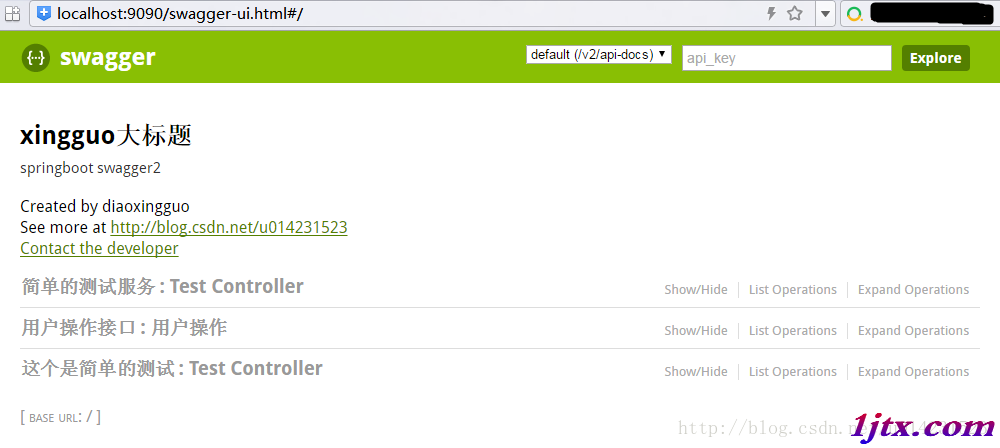
點擊ApiInfoBuilder.Java的源碼可以看到相關方法使用。
第三步就是在自己的controller添加相關的注解:
原來使用在類上使用@controller,現在可以使用@RestController,然後方法的@ResponseBody就可以不用寫了,因為@RestController的注解接口上已經添加了,要求版本在4.0.1之後。
@Target(ElementType.TYPE)
@Retention(RetentionPolicy.RUNTIME)
@Documented
@Controller
@ResponseBody
public @interface RestController {
/**
* The value may indicate a suggestion for a logical component name,
* to be turned into a Spring bean in case of an autodetected component.
* @return the suggested component name, if any
* @since 4.0.1
*/
String value() default "";
}
常用的注解如下:
- @Api()用於類名
- @ApiOperation()用於方法名
- @ApiParam()用於參數說明
- @ApiModel()用於實體類
- @ApiModelProperty用於實體類屬性
更加詳細的含義可以參考官方說明wiki
下面會用代碼和示例圖說明。
第四部就是在啟動項目在浏覽器上輸入url:
http://{ip}:{port}/swagger-ui.html#/
我在application.properties中設置的自己的端口號為9090(如果不設置,默認為8080)
server.port=9090
所以我的url是:http://localhost:9090/swagger-ui.html
如圖:
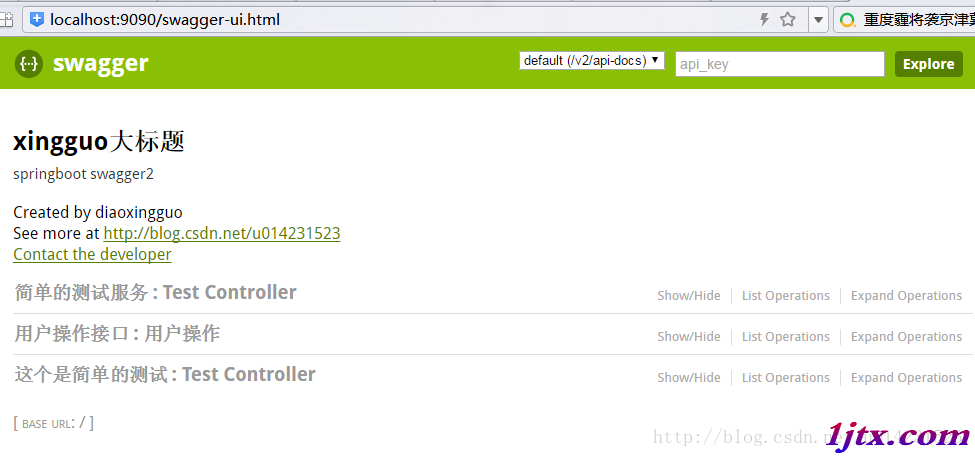
這裡會把相應包下的所有controller按類進行顯示。
我們看下其中一個類UserController.java,(請忽略業務邏輯,只看注解)
package com.xingguo.springboot.controller;
import io.swagger.annotations.Api;
import io.swagger.annotations.ApiOperation;
import io.swagger.annotations.ApiParam;
import javax.annotation.Resource;
import org.springframework.web.bind.annotation.GetMapping;
import org.springframework.web.bind.annotation.PostMapping;
import org.springframework.web.bind.annotation.RequestBody;
import org.springframework.web.bind.annotation.ResponseBody;
import org.springframework.web.bind.annotation.RestController;
import com.xingguo.springboot.model.User;
import com.xingguo.springboot.service.UserService;
/**
* Created by diaoxingguo on 2016/10/24.
*/
@Api(value="用戶controller",description="用戶操作",tags={"用戶操作接口"})
@RestController
public class UserController {
@Resource
private UserService userService;
@ApiOperation("獲取用戶信息")
@GetMapping("/getUserInfo")
public User getUserInfo(@ApiParam(name="id",value="用戶id",required=true) Long id,@ApiParam(name="username",value="用戶名") String username) {
User user = userService.getUserInfo();
return user;
}
@ApiOperation("更改用戶信息")
@PostMapping("/updateUserInfo")
public int updateUserInfo(@RequestBody @ApiParam(name="用戶對象",value="傳入json格式",required=true) User user){
int num = userService.updateUserInfo(user);
return num;
}
@ApiOperation("添加用戶信息")
@PostMapping("/saveUser")
public String saveUser(@RequestBody @ApiParam(name="user",value="json fromat",required=true) User user) {
userService.saveUser(user);
return "success";
}
}
這裡說明下,在使用對象作為參數時,可以在對象上添加相應的注解,用戶頁面顯示。
如:
package com.xingguo.springboot.model;
import io.swagger.annotations.ApiModel;
import io.swagger.annotations.ApiModelProperty;
import java.util.List;
/**
* Created by diaoxingguo on 2016/10/24.
*/
@ApiModel(description="用戶對象user")
public class User {
@ApiModelProperty(value="用戶名",name="username")
private String username;
@ApiModelProperty(value="狀態",name="state",required=true)
private Integer state;
private String password;
private String nickName;
private Integer isDeleted;
private String[] ids;
private List<String> idList;
public String getUsername() {
return username;
}
public void setUsername(String username) {
this.username = username;
}
public Integer getState() {
return state;
}
public void setState(Integer state) {
this.state = state;
}
public String getPassword() {
return password;
}
public void setPassword(String password) {
this.password = password;
}
public String[] getIds() {
return ids;
}
public void setIds(String[] ids) {
this.ids = ids;
}
public List<String> getIdList() {
return idList;
}
public void setIdList(List<String> idList) {
this.idList = idList;
}
public String getNickName() {
return nickName;
}
public void setNickName(String nickName) {
this.nickName = nickName;
}
public Integer getIsDeleted() {
return isDeleted;
}
public void setIsDeleted(Integer isDeleted) {
this.isDeleted = isDeleted;
}
}
顯示的效果如圖:
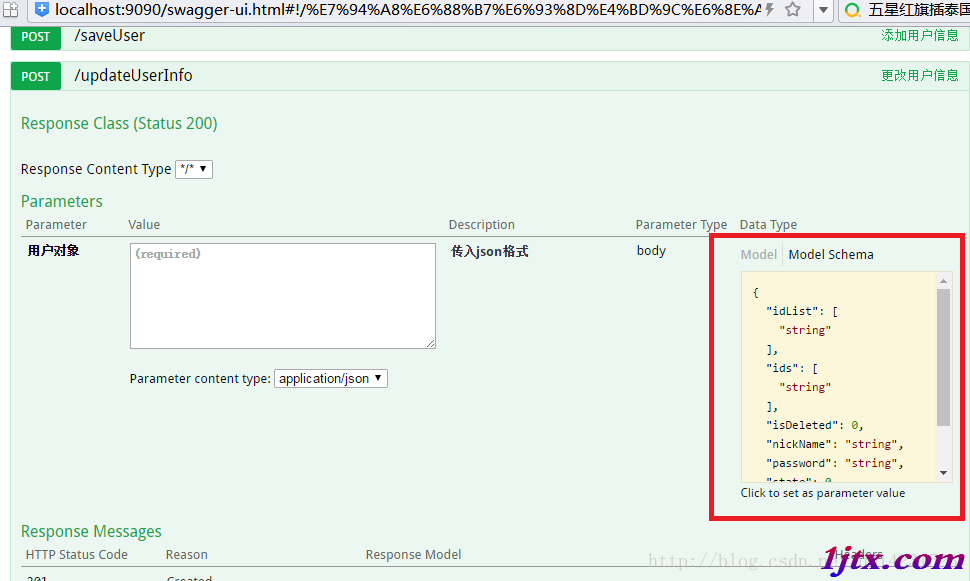
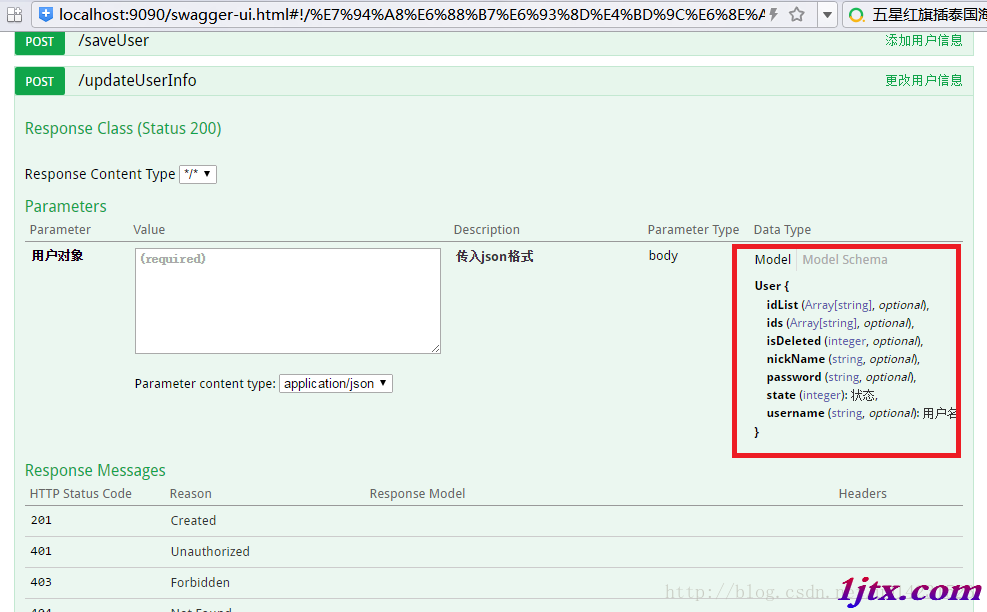
看上圖紅框的部分,其中一個是json格式的點擊就可以獲取參數格式。
第二張中可以看到字段相應的注釋和是否必填。
如果在字段上添加注釋@ApiModelProperty(required=true)就是必填(默認是false),相應的頁面optional標識也會消失,標識這個字段必填。
點擊下面的try it out按鈕就可以進行調試。
在使用單個參數時,如上面代碼中的getUserInfo()方法,對應的效果圖如下:
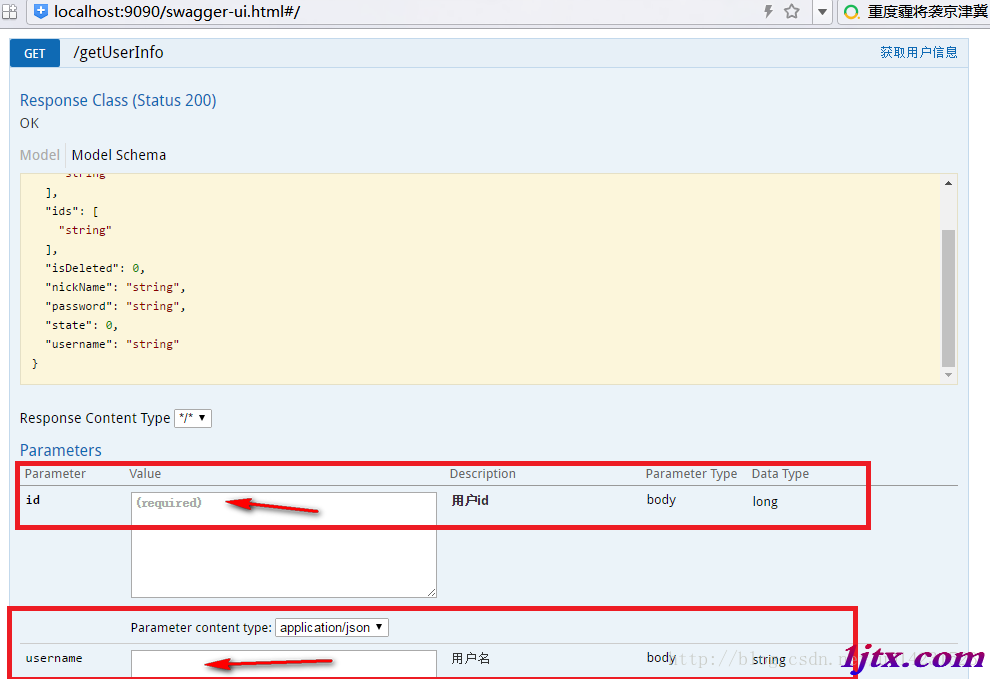
這裡如果是添加required=true, @ApiParam(required=true)則會在頁面上顯示required的標識。同樣默認為false。
其他的使用方式可以自己動手試試。
總結
以上就是這篇文章的全部內容了,希望本文的內容對大家的學習或者工作能帶來一定的幫助,如有疑問大家可以留言交流,謝謝大家對的支持。